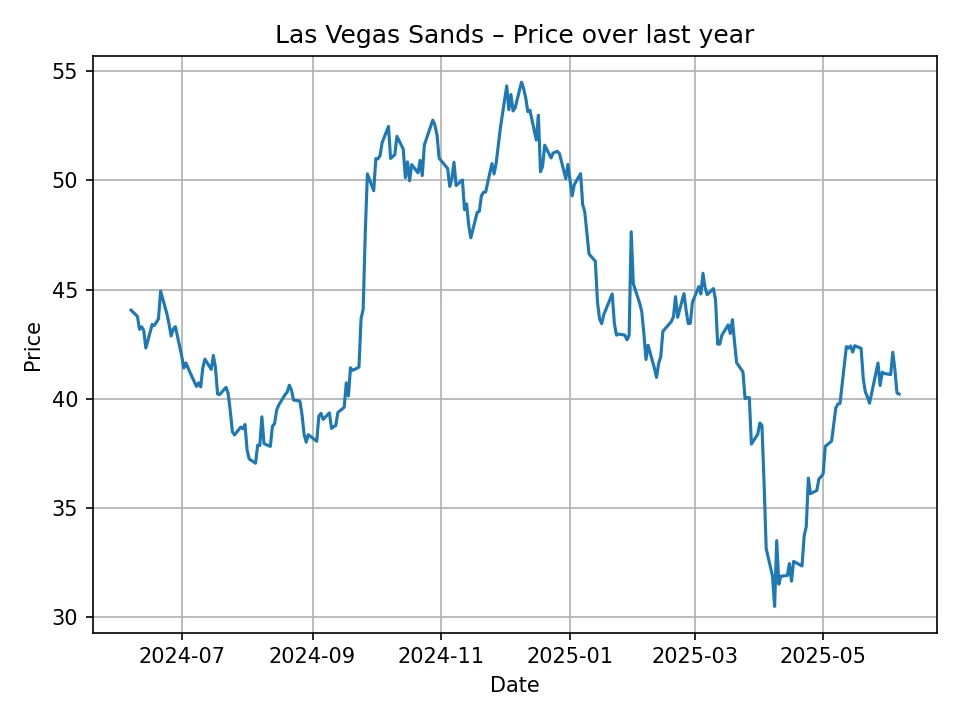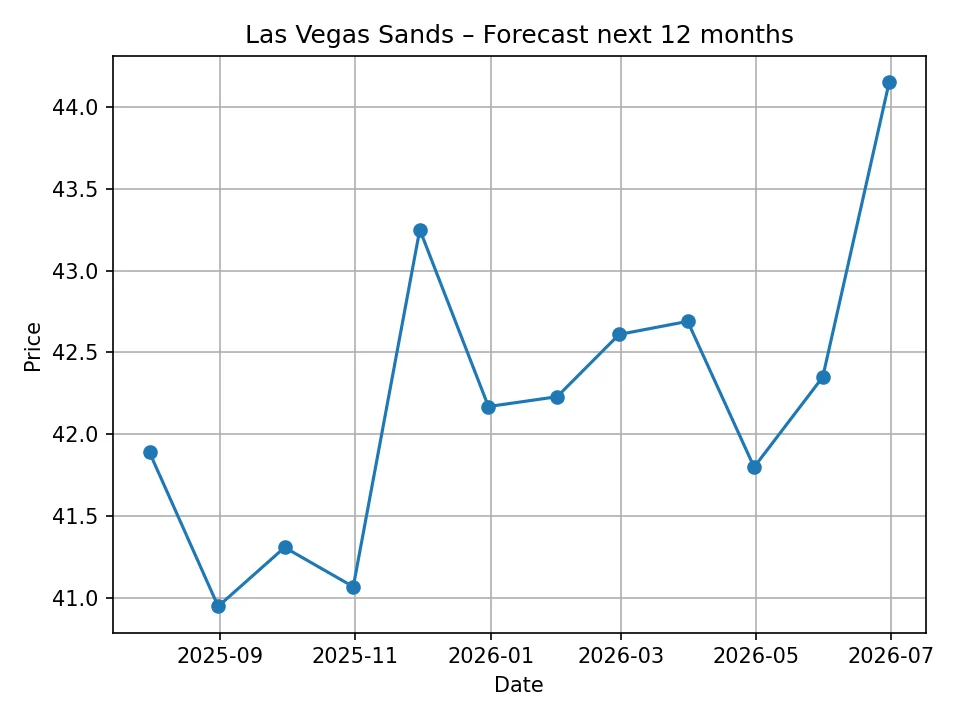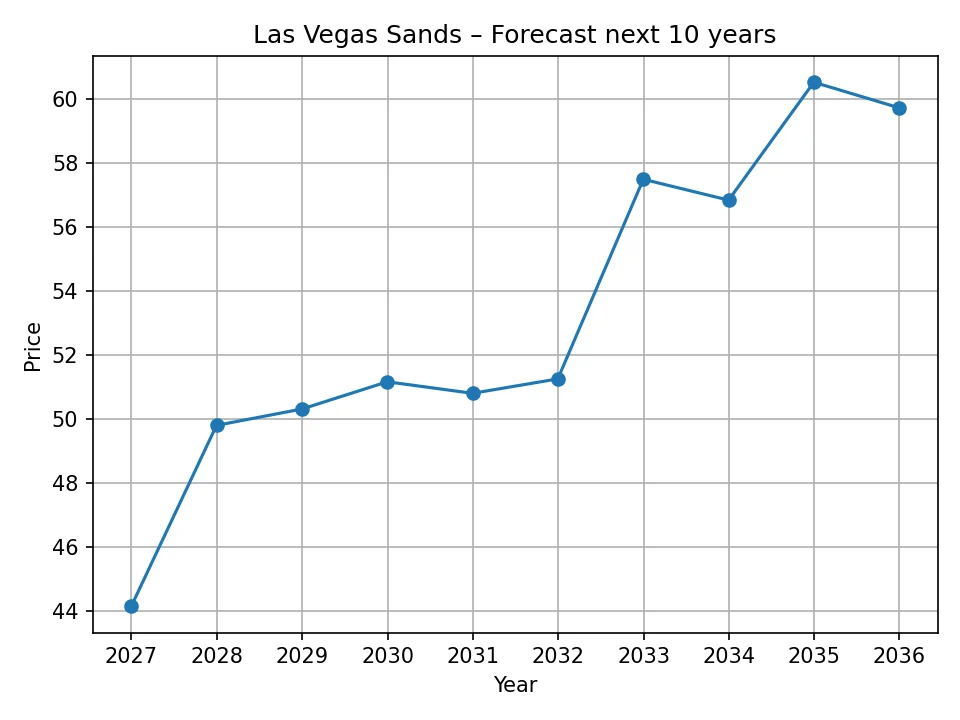Las Vegas Sands (LVS) stands as a monumental force in the global integrated resort industry, distinguished by its portfolio of world-class properties that combine gaming, entertainment, retail, convention facilities, and luxury hospitality. As of the current market assessment, Las Vegas Sands shares are trading at 40.22 USD. Investors and market observers are keenly interested in understanding the potential trajectory of LVS stock, given the dynamic global economic landscape and the evolving nature of the leisure and tourism sectors. This comprehensive analysis delves into the intricate factors shaping LVS’s market position, reviews its recent performance, and presents an algorithmic forecast for its price over the coming months and years.
Understanding Las Vegas Sands’ Core Business
Las Vegas Sands Corporation, a pioneer and leader in the development and operation of integrated resorts, has strategically pivoted its focus away from its namesake city to concentrate on the burgeoning markets of Asia. Following the sale of its Las Vegas assets, LVS’s primary operations are now centered in Macau, China, and Singapore. These two regions represent some of the most lucrative and strategically important gaming and MICE (Meetings, Incentives, Conferences, and Exhibitions) destinations globally.
In Macau, LVS operates an impressive array of properties including The Venetian Macao, The Londoner Macao, The Parisian Macao, and Sands Macao. These properties are not merely casinos; they are sprawling integrated resorts offering a diverse range of amenities designed to attract both high-net-worth individuals and mass-market tourists. The company’s significant investment in non-gaming amenities, such as luxury retail malls, convention centers, and entertainment venues, aligns with the Macanese government’s push for diversification beyond traditional gaming. This strategy has proven resilient, allowing LVS to capitalize on multiple revenue streams and cater to a broader demographic.
Singapore is home to LVS’s iconic Marina Bay Sands, a landmark property renowned for its architectural marvel, luxury hotel, extensive convention center, high-end retail mall, and world-class entertainment options. Marina Bay Sands is consistently a significant contributor to LVS’s overall revenue and profitability, serving as a key gateway for business and leisure tourism in Southeast Asia. The company’s commitment to expanding and enhancing this property, as demonstrated by ongoing development plans, underscores its belief in the long-term potential of the Singapore market.
The strategic emphasis on Asia allows LVS to tap into the vast and growing consumer base of the region, particularly the burgeoning middle class in China and Southeast Asia. The company’s integrated resort model, with its emphasis on MICE business, provides a stable revenue foundation, as corporate events and conventions often have a longer planning cycle and are less susceptible to short-term economic fluctuations compared to pure gaming revenue. This diversified approach also positions LVS favorably in regulatory environments that increasingly favor non-gaming tourism contributions.
Recent Historical Performance Analysis
Examining the historical price data for Las Vegas Sands over the past 12 months provides crucial context for its current valuation and future projections. The stock has experienced considerable volatility, reflecting the inherent sensitivities of the gaming and tourism sectors to global economic conditions, travel sentiment, and geopolitical dynamics. The provided daily historical data points show a range of prices, illustrating periods of both significant upward momentum and notable pullbacks.

Starting at around 44.06 USD at the beginning of the period, LVS shares initially saw some fluctuations, dipping into the low 40s and high 30s. There were periods where the stock entered a tougher patch, notably falling into the 37-39 USD range for several weeks. This period of lower prices likely corresponded to renewed concerns about global economic slowdowns, specific regulatory developments in Macau, or lingering impacts from travel restrictions. The gaming industry, by its very nature, is highly cyclical and sensitive to consumer discretionary spending, which can be easily affected by broader economic anxieties.
A more pronounced rally appears to have commenced around the second half of the historical data, where prices began a steady climb from the high 30s. The stock broke above the 40 USD mark, then 45 USD, and impressively touched the low 50s, peaking around 54.49 USD. This robust recovery phase can be attributed to several factors. First, a significant easing of travel restrictions, particularly in Asia, would have played a pivotal role, allowing for a stronger return of international tourism to Macau and Singapore. Increased visitation and higher spending per patron directly translate into improved revenue for LVS’s properties. Second, positive economic indicators, improved consumer confidence, and a more stable geopolitical environment could have bolstered investor sentiment towards growth-oriented leisure stocks. Finally, company-specific announcements, such as progress on expansion projects or positive financial results, might have also contributed to this upward trend.
However, the stock did not sustain its peak, demonstrating the continued presence of market pressures. After reaching highs in the mid-50s, the price began to trend downwards, eventually settling at the current 40.22 USD. This recent decline suggests that some of the initial optimism may have tempered, or new concerns have emerged. Potential reasons for this pullback could include:
- Renewed fears of economic slowdown impacting discretionary spending.
- Increased competition in key markets.
- Specific regulatory uncertainties or changes in Macau that might impact future profitability.
- General market corrections affecting growth stocks.
- Profit-taking by investors after the strong rally.
The current price of 40.22 USD reflects a level similar to the earlier part of the 12-month period, indicating that while there was a significant surge, the stock has since retreated, consolidating some of its gains. This historical context underscores the volatility and sensitivity of LVS shares to various internal and external factors, making comprehensive analysis essential for prospective investors.
Key Factors Influencing Las Vegas Sands’ Stock Price
The future performance of Las Vegas Sands stock is intricately linked to a complex interplay of macroeconomic trends, industry-specific developments, and company-specific initiatives. Understanding these drivers is crucial for a nuanced price forecast.
Macroeconomic Environment
The global economic outlook is paramount for LVS. Strong global GDP growth, particularly in China and Southeast Asia, generally translates to higher disposable incomes and increased propensity for leisure travel and entertainment. Conversely, economic slowdowns or recessions can significantly dampen consumer spending on luxury experiences and tourism, directly impacting LVS’s core business. Inflationary pressures and rising interest rates can also affect the company by increasing operating costs and the cost of debt, while simultaneously reducing consumer purchasing power. Currency fluctuations, especially the strength of the U.S. dollar against Asian currencies, can impact reported revenues and profitability for a company with significant international operations.
Tourism and Travel Trends
The health of the global tourism sector, particularly cross-border travel, is a direct determinant of LVS’s success. The complete reopening of international borders, robust airline capacity, and the recovery of MICE events are vital. Any resurgence of health crises or new travel restrictions could severely impede visitor numbers. Furthermore, evolving consumer preferences, such as a greater emphasis on unique experiences, wellness tourism, or digital integration, could influence the attractiveness of integrated resorts. LVS’s ability to adapt its offerings to these changing trends will be critical.
Regulatory Landscape in Key Markets
Regulatory environments in Macau and Singapore are perhaps the most significant external factor for LVS. In Macau, the government’s stance on gaming concessions, the number of gaming tables and slots permitted, and the drive for diversification into non-gaming attractions directly impact the company’s operational framework and revenue potential. Any changes in taxation, visa policies, or anti-gaming measures could have profound effects. Similarly, in Singapore, while more stable, any shifts in regulatory oversight for Marina Bay Sands could influence its operations. LVS has successfully navigated these landscapes in the past, but continuous monitoring of policy changes is imperative.
Competition
The integrated resort market is intensely competitive. In Macau, LVS competes with other major players like Galaxy Entertainment, MGM China, SJM Holdings, Wynn Macau, and Melco Resorts & Entertainment. In Singapore, Marina Bay Sands shares the duopoly with Resorts World Sentosa. The competitive landscape necessitates continuous innovation in offerings, effective marketing strategies, and efficient operations to attract and retain customers. New market entrants or significant expansions by competitors could exert pressure on LVS’s market share and profitability.
Company-Specific Initiatives and Financial Health
LVS’s strategic investments in existing properties, such as the multi-billion dollar expansion of Marina Bay Sands, are crucial for long-term growth. These projects are designed to enhance non-gaming offerings, increase capacity, and cement LVS’s competitive advantage. The company’s financial health, including its debt levels, cash flow generation, and dividend policy, are also important considerations. A strong balance sheet provides resilience against economic downturns and allows for future investments. Management’s ability to execute on its strategic vision, control costs, and optimize revenue streams will directly impact shareholder value. Furthermore, the company’s commitment to sustainability and responsible gaming practices is increasingly important for investor perception and regulatory compliance. Geopolitical relations, especially between the U.S. and China, can also cast a shadow, potentially influencing travel policies or investment sentiment towards businesses with significant exposure to Chinese markets.
Short-Term Price Forecast (Next 12 Months)
Our proprietary forecasting algorithm, EchoPredict, has analyzed the historical data and current market conditions to generate a 12-month price projection for Las Vegas Sands (LVS). The algorithm identifies trends, volatility patterns, and correlations to provide a forward-looking estimate.
The monthly forecast suggests a relatively stable to slightly upward trend for LVS over the coming year, with some anticipated fluctuations month-to-month. The current price of 40.22 USD serves as the baseline for these projections. According to EchoPredict, the stock is expected to see moderate gains in the initial months, indicating a potential stabilization and minor recovery from its current level. This could be driven by continued travel recovery, positive macroeconomic signals, or specific company news that instills short-term confidence.
The forecast indicates that LVS could fluctuate within a range, generally remaining above its current price for much of the period. The highest predicted price in this 12-month window is 44.15 USD by June 2026. This suggests a gradual appreciation over the year, punctuated by some minor dips as market sentiment or specific news events create temporary headwinds. For instance, the forecast shows a slight dip in August 2025 and October 2025, which could reflect seasonal variations in tourism or minor market corrections. However, these are projected to be short-lived, with the overall trend leaning towards a positive trajectory.
This short-term stability and modest growth projection imply that the algorithm anticipates a relatively healthy operating environment for LVS’s integrated resorts, supported by steady tourism flows and a stable regulatory framework in its key Asian markets. Investors should monitor quarterly earnings reports, visitor statistics for Macau and Singapore, and any regulatory updates closely, as these can significantly influence short-term price movements.

Here is the detailed monthly price forecast for Las Vegas Sands:
| Month/Year | Projected Price (USD) |
|---|---|
| 2025-07 | 41.89 |
| 2025-08 | 40.95 |
| 2025-09 | 41.31 |
| 2025-10 | 41.07 |
| 2025-11 | 43.25 |
| 2025-12 | 42.17 |
| 2026-01 | 42.23 |
| 2026-02 | 42.61 |
| 2026-03 | 42.69 |
| 2026-04 | 41.80 |
| 2026-05 | 42.35 |
| 2026-06 | 44.15 |
Long-Term Price Forecast (Next 10 Years)
Looking further into the future, the EchoPredict algorithm provides a 10-year annual price forecast for Las Vegas Sands, offering insights into the stock’s potential long-term growth trajectory. The long-term forecast anticipates a more significant upward trend for LVS shares, reflecting the company’s strategic positioning in growth markets and the expected continued expansion of the global tourism and entertainment industries.
The forecast suggests a consistent appreciation in LVS’s stock price over the next decade. From the projected 44.15 USD in 2026, the price is expected to steadily climb, reaching notable milestones. This long-term growth projection is likely underpinned by several fundamental assumptions: continued recovery and expansion of Asian tourism markets, successful execution of LVS’s strategic development projects (such as the Marina Bay Sands expansion), sustained demand for integrated resort experiences, and potentially stable or favorable regulatory environments. The diversified revenue streams from gaming, retail, MICE, and hospitality are expected to contribute to this sustained growth.
The algorithm predicts LVS to breach the 50 USD mark in 2027, reaching 49.80 USD, and continuing to rise thereafter. By 2032, the forecast indicates a significant jump to 57.48 USD, with further gains projected to reach 60.51 USD by 2034, before a slight moderation in the final year of the forecast to 59.71 USD in 2035. This suggests that while there may be minor fluctuations or periods of consolidation, the overall long-term trend for LVS is robustly positive. This reflects the company’s strong brand, prime locations, and ability to generate substantial cash flows from its high-quality assets. The long-term outlook also likely accounts for potential increases in discretionary spending globally and the growing affluence in Asian economies, which will continue to fuel the integrated resort market.

Here is the detailed annual price forecast for Las Vegas Sands:
| Year | Projected Price (USD) |
|---|---|
| 2026 | 44.15 |
| 2027 | 49.80 |
| 2028 | 50.31 |
| 2029 | 51.16 |
| 2030 | 50.80 |
| 2031 | 51.25 |
| 2032 | 57.48 |
| 2033 | 56.83 |
| 2034 | 60.51 |
| 2035 | 59.71 |
Potential Risks and Uncertainties
While the forecasts indicate a generally positive outlook for Las Vegas Sands, it is imperative for investors to be aware of the inherent risks and uncertainties that could impact these projections. Stock market predictions are inherently subject to change based on unforeseen events and evolving market conditions.
One of the foremost risks for LVS is the regulatory environment in Macau. Despite the recent stability following new gaming concessions, any future shifts in government policy regarding gaming limits, taxation, or the balance between gaming and non-gaming revenue could significantly alter the company’s profitability. Political developments in China and their implications for Macau’s autonomy also bear watching.
Global economic downturns or recessions pose a substantial threat. Integrated resorts rely heavily on discretionary spending, which is often the first to be cut during economic hardship. A significant and prolonged economic slowdown in key source markets like China, or globally, could lead to reduced visitation and lower spending per customer, directly impacting LVS’s revenues.
Geopolitical tensions, particularly between the United States and China, could create headwinds. Such tensions might lead to restrictions on travel, affecting visitor numbers to Macau, or could impact investor sentiment towards companies with significant exposure to the region. Even perception of heightened tensions can deter travel and investment.
The tourism industry remains vulnerable to unforeseen global events, such as new pandemics, natural disasters, or major security incidents. While the world has largely recovered from the recent global health crisis, the possibility of future outbreaks or other disruptions to international travel remains a concern, which could lead to renewed travel restrictions and a slowdown in business.
Intense competition in both Macau and Singapore could also pressure LVS’s market share and margins. Other operators are also investing heavily in their properties and marketing efforts. Failure to innovate or maintain a superior customer experience could lead to a loss of competitive edge.
Furthermore, LVS’s capital expenditure commitments, particularly for the expansion of Marina Bay Sands, are substantial. While these investments are crucial for long-term growth, delays, cost overruns, or a failure to generate anticipated returns could negatively impact financial performance. The company’s debt levels and its ability to service this debt during challenging periods also represent a financial risk. Finally, shifts in consumer preferences towards alternative forms of entertainment or travel destinations could also pose a long-term challenge if LVS fails to adapt its offerings.
Investment Considerations
For investors considering Las Vegas Sands (LVS) shares, the company presents a compelling case due to its dominant position in lucrative Asian markets and its diversified integrated resort model. The long-term growth prospects, as indicated by our forecast, suggest that LVS is well-positioned to capitalize on the increasing affluence in Asia and the continued expansion of the global tourism sector. Its focus on non-gaming amenities also aligns with broader governmental goals in Macau and offers a more resilient revenue stream.
However, the investment is not without its challenges. The stock’s susceptibility to regulatory changes, particularly in Macau, and its sensitivity to macroeconomic fluctuations underscore the need for a cautious approach. Investors should perform thorough due diligence, assessing LVS’s financial statements, management strategy, and exposure to various geopolitical and economic risks. Diversification within an investment portfolio is always advisable to mitigate risks associated with any single stock. Given the current price of 40.22 USD, investors might view this as a potential entry point given the projected long-term growth, but it is critical to weigh the risks carefully.
In conclusion, Las Vegas Sands remains a significant player in the global entertainment and hospitality industry, with a strong foundation in high-growth Asian markets. While past performance has shown volatility, the algorithmic forecasts point towards a positive trajectory for LVS stock in both the short and long term, reflecting the company’s strategic strengths and the anticipated recovery and expansion of the global tourism sector.
Please note that all price forecasts and analyses presented in this article are generated by our proprietary algorithm, EchoPredict, and are based on historical data and current market conditions. We are not responsible for the accuracy of these price forecasts, as stock market performance is subject to numerous unpredictable factors. Investors should conduct their own comprehensive research and consult with a qualified financial advisor before making any investment decisions.

Sophia Patel brings deep expertise in portfolio management and risk assessment. With a Master’s in Finance, she writes practical guides and in-depth analyses to help investors build and protect their wealth.